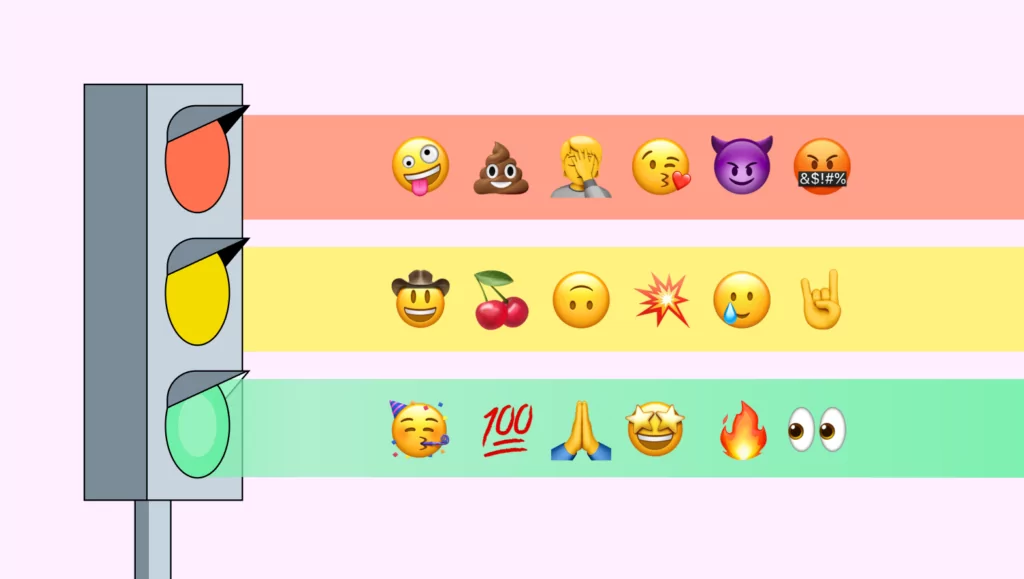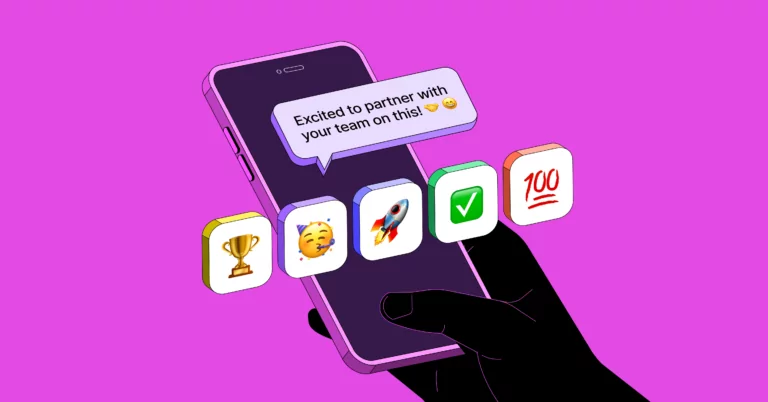With the rise in remote and hybrid work models, companies have been increasingly relying on text-based platforms, like Slack and Microsoft Teams, at work. And with that rise comes the increasing use of emojis in business communication — with all their glorious potential for miscommunication.
Ahead of writing this post, I chatted with a few friends about emoji mishaps at work, and it seemed everybody had a story. One friend’s boss had an unfortunate penchant for responding to everything with the fire emoji (🔥). Another said that when their company onboarded an overseas customer support agency, they had to ask the agency employees to stop using the turkey emoji (🦃) in their interactions with customers.
While entertaining, these stories highlight just how frequently emojis can cause miscommunication, especially when colleagues from different generations and cultures are interacting. Gen Z, for instance, tends to use emojis more commonly and with more creativity than those from older generations do, while one study found East Asian individuals tend to use more emojis than their American counterparts.
Emoji use is clearly common in the workplace, so whether you use them yourself or not, it’s helpful to know how to interpret and use them appropriately.
4 reasons to use emojis in a business context💡
Today, 70% of individuals report using emojis at work, and for good reason: emojis can clarify messages, help emails stand out, and strengthen relationships.
1. To convey emotions
Considering that 60% of face-to-face communication is nonverbal, it can be hard to convey emotions through text alone. For example, when a direct report receives a Slack message that says, “Do you have 10 minutes to receive some feedback?” they can’t read their boss’ facial expression and vocal tone to tell if that meeting will be casual or critical.
According to Adobe, 91% of individuals say they use emojis for exactly this reason: because it makes it easier to express themselves.
2. To set status updates
At this stage, emoji use is so ubiquitous that emojis are often used as a form of shorthand communication. For instance, communication platforms like Slack and OpenPhone let users set emoji status updates, making it easy for you to let coworkers know if you’re on vacation (🌴), in deep work mode (💻), having lunch (🥪), or in a meeting (🗓️).
3. To help emails stand out
In a sea of marketing emails, adding a strategic emoji to your subject line or preview text can help recipients get a sense of what your email is about. Just take a look at how the emojis included in the preview messages below help convey a sense of urgency or hint at the topic at hand:



According to Return Path, using emojis can increase your email open rates. To use emojis in a similar way in your marketing copy, you might use a 💡 when you’re sharing interesting ideas, 📚 when sending resources, or 🥳 when celebrating a milestone.
4. To build culture and relationships
Anecdotal evidence shows that leaders in charge of remote teams can strengthen interpersonal bonds by using emojis. Since emojis convey emotions, they can help remote teams connect more easily and develop deeper relationships.
“When emailing customers, I don’t use regular emojis — even the text emojis — as they seem less professional and can tone down the sense of urgency or importance of support cases I’m working on,” says Miguel Cruz, Quality and Training Specialist at OpenPhone. “However, in internal communications such as Slack, they’re a great way to convey my thoughts and engage with colleagues.”
When emojis are inappropriate at work 🙅
While emojis can help provide emotional context in text-based conversations, there are some situations that they’re best left out of.
1. Formal conversations
Regardless of how you might like to use emojis personally, most of the time they’re seen as more appropriate in casual conversations. In formal contexts, using emojis is generally seen as unprofessional — especially when used by upper management.
When a conversation at work touches on more serious matters, such as hiring or firing an employee, discussing compensation, or conducting a performance review, it’s best to skip emojis.
2. Conversations with customers
While a real-life smile can help break the ice with potential customers, it’s best to keep emojis out of your text-based communication with customers and potential clients. Research shows that — unlike actual smiles — the use of emojis can decrease perceptions of one’s competence. This can lead clients to share less information with you (the exact opposite of what you want to best support them).
“I’d generally refrain from using emojis when talking to customers,” says Drew Schuffenhauer, Customer Support Lead at OpenPhone. “You don’t want to send something that could potentially be misinterpreted, and when working with a geographically diverse customer base, you might not know if a symbol has a different meaning elsewhere from what you’re used to it meaning.”
To play it safe, omit the use of emojis from your customer conversations — especially if you don’t have a pre-existing relationship with them.
3. Corporate environments
In general, emojis are more widely accepted in more casual work environments, such as startups and small businesses. In more formal or corporate environments, emoji use is generally seen as unprofessional.
For instance, if a marketing agency’s CEO used emojis with clients over Slack, it would usually be taken as nothing more than a friendly gesture. However, if a lawyer or doctor used the same emojis in their client communications, their clients might question their professionality or competence.
Emojis that are appropriate to use at work 👌
Now that we’ve covered when emojis are appropriate to use, let’s get down to the specifics: which emojis are appropriate to use.

Emojis for celebrating 🎉
One of the best times to use emojis within internal communications is to cheer your team on. People appreciate colleagues wishing them a happy birthday, celebrating a work anniversary, or acknowledging a promotion. Recognizing employees for a job well done is also one of the best ways to boost employee engagement and build a positive company culture.
“The use of emojis depends on the tone you want to project,” says Tiffany Olsen, People Operations Coordinator at OpenPhone. At OpenPhone, Tiffany shares short posts for team members’ birthdays and work anniversaries within a “Celebrations” Slack channel. She continues:
“At OpenPhone, our vibe is informal and fun-loving, as opposed to other companies that may be more formal and ‘buttoned up.’ In some instances, emojis may not be appropriate; however, in the types of celebratory announcements that I post, emojis make it more friendly and exciting.”
Ready to celebrate your team? Here are some work-safe emojis for celebrating birthdays, milestones, and accomplishments.
General celebration emojis
- 🥳 Partying face
- 🎉 Party popper
- 🎊 Confetti ball
- 🍾 Bottle with popping cork
Birthday celebration emojis
- 🎂 Birthday cake
- 🎈 Balloon
- 🎁 Wrapped gift
Good job/praise emojis
- 🙌 Raising hands
- 👏 Clapping hands
- 💯 100 points or 100 percent: used to express approval
- 🔥 Fire: this is like saying “Nice!”
- 🌟 Star
Emojis for engaging with your team 🤝
While emojis can be a great, emotive addition to messages, they can also simply serve as confirmation that you’ve seen a message or as a quick response. For instance, people will often ask questions or make requests on platforms like Slack, OpenPhone, or Microsoft Teams. If you don’t have an immediate response but want to acknowledge the message, it can be useful to use an emoji.
“I definitely use emojis for informal communication with our team, which can be a great tool to build culture,” says Drew. Not only that, but studies have shown that a leader’s use of positive emojis can even enhance team members’ creativity.
Task-related emojis
- 👀 Taking a look
- ✅ /✔️Done/completed a task
- 🤔 Thinking face
Laughing emojis
- 😂 Face with tears of joy
- 🤣 Rolling on the floor laughing
Friendly emojis
- 👋 Wave
- 🙏 Thank you
- 👍 Thumbs up
- 🤩 Star-struck
- 🙂 Smiley face
- ❤️ Heart
Emojis to avoid using at work 👎
Since teams are made up of individuals from different generations, backgrounds, and cultures, it’s best to stay away from certain emojis that could be misinterpreted or have mixed meanings. A good rule of thumb is if you’re not sure of an emoji’s meaning or how it might be interpreted, skip it altogether.
- 😈 Devil/up to no good: some see it as innocent or cheeky, while others see it as more of a sexual innuendo
- 🤪 Tongue out: unclear meaning, not professional
- 💩 Pile of poo: this is emoji users’ least favorite emoji to use across all generations
- 🤦 Facepalm: this can indicate a range of emotions (including embarrassment or frustration), making its meaning often unclear to recipients
- 🙃 Upside-down smile: this emoji ranks in the top 3 most misunderstood emojis since it can represent sarcasm, silliness, or humor
- 😠 Angry face: this emoji can make you seem unfriendly or overly emotional, which you likely want to avoid at work
5 tips for using emojis in business communication 📨
Emojis can be a fun way to connect people across cultures and age groups — but, as we’ve shared, they can also be a landmine for miscommunication. To help you feel more comfortable using them, here are a few tips.
1. Stick to using emojis in informal messages
If in doubt, leave the emojis out. While emojis are a great fit for casual Slack conversations, they don’t belong in business-first emails or more serious messages.
2. Use mirroring when it comes to external communication
Not sure how a potential customer will react to emojis? Follow their lead. Some customers might love using emojis, while others may leave them out completely. Mirroring a customer’s communication style can help increase your levels of trust, liking, and rapport.
“I love the idea of ‘matching someone’s energy,’” says Steph Guerin, Talent Coordinator at OpenPhone. “If I’m speaking with candidates during the recruiting process, I’ll absolutely use emojis if I’m getting them sent to me. I feel like it’s a really nice way to humanize the process and my replies, but there are also times when I feel like it’s more professional not to use them. I use them on a case-by-case basis.”
3. Know your audience
Professionals over 45 years old are more likely to say emoji use at work is inappropriate, while nearly half of young adults (18 to 29 years old) think emojis are work-appropriate. If you’re unsure about including emojis, consider your audience.
4. Be careful with skin modifiers
Many communication platforms, like Slack, will allow you to modify the skin tone of their emojis — but using an emoji skin tone that doesn’t match your own is generally looked down upon. In fact, over 50% of emoji users say that using the wrong emoji skin tone is uncomfortable and insensitive. Stick to your own skin tone when selecting emojis.
5. Don’t use emojis if you’re unsure what they mean
Not sure what 🤠, 🍒, or 🙃 mean? Then keep them out of your conversations! According to an Adobe survey, four in five emoji users think you should only use an emoji if you understand the context of it in a conversation. Otherwise, you risk your message being lost in translation.
Streamline your team’s communication with OpenPhone
Emojis can be a great way to boost your team’s communication, but since they’re constantly evolving, it’s important to be mindful of using them in the right context. To learn other ways to enhance your team’s internal and external communication, check out our product and explore our SMS texting etiquette guide to help you navigate texting your customers with grace.
